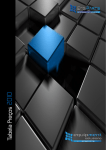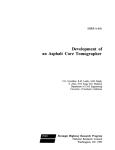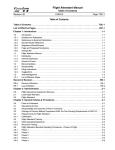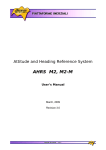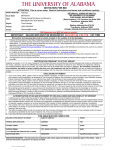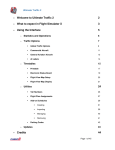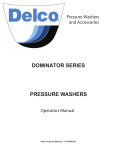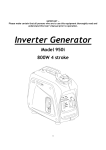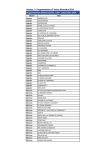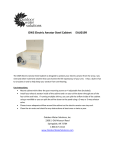Download Safety Procedures and Practices Statement
Transcript
Safety Procedures and Practices Statement Name:____________________ I have received a copy of the Summit Aviation’s Safety Procedures and Practices and will comply with all procedures set forth therein. Sign and date here:_______________________________________ This document must be kept in the student’s record at all times. A-1 Revised 18-Feb-13 Weather Minimums General: A. Day VFR minimums are 2,000 foot ceiling and 5 miles visibility for the Traffic Pattern, 3500’ ceiling and 5 miles visibility for all other flights. Pattern work may be conducted with an instructor with 1,500’ ceiling and 3 SM visibility. B. Night VFR minimums are 3,500 foot ceiling and 7 miles visibility. Pattern work may be conducted with an instructor with 1,500’ ceiling and 3 SM visibility. C. Weather minimums for IFR takeoff shall be no lower than the lowest compatible circling minimums, both ceiling and visibility, at the departure airport or takeoff minimums listed in the Terminal Flight Information Publication for the airport, whichever are greater. D. Unless accompanied by a company instructor, flight will not be initiated when the surface winds exceed the maximum crosswind component according to the aircraft flight manual or pilot operating handbook. Pilots shall not takeoff when a tailwind component exceeds 5 Knots. E. Unless accompanied by a company instructor, flight will not be initiated if surface winds, including gusts, are greater than 20 knots, and flights will be terminated as soon as practicable if surface winds exceed 20 knots. F. Flight under special VFR, as defined in FAR Part 91, is limited to special approval by the Chief Flight Instructor. All other flights under these conditions must be flown IFR. Students Pilots: A. Day VFR minimums are 2,000 foot ceiling and 5 miles visibility for the Traffic Pattern, 3500’ ceiling and 5 miles visibility for all other flights. Pattern work may be conducted with an instructor with 1,500’ ceiling and 3 SM visibility. B. Night VFR minimums N/A without an instructor C. Weather minimums for IFR takeoff N/A D. Student solo flights will not be dispatched when surface winds exceed 7 knots calculated crosswind unless authorized by their CFI. Pilots shall not takeoff when a tailwind component exceeds 5 Knots. E. Student solo flights will not be initiated if surface winds, including gusts, are greater than 20 knots, and flights will be terminated as soon as practicable if surface winds exceed 20 knots. F. Flight under special VFR N/A A-2 Revised 18-Feb-13 Aircraft Dispatch Procedures A. Pilots must obtain the Aircraft Dispatch Log from a Summit employee. Prior to dispatching an aircraft, the Summit employee must first check the Aircraft Squawk Log to ensure the aircraft is ready and safe for flight prior to surrendering the dispatch log to a student. B. Aircraft will not be dispatched to solo student pilots unless authorization is verified. All flights with a student pilot flying solo will be dispatched by a flight instructor, who is present at the airport and verifies the student's qualifications for solo as well as weather conditions for the proposed flight. C. If a student pilot makes an unscheduled landing, the aircraft will not be re-dispatched without the Chief Flight Instructor or Owner’s authorization. D. If any pilot makes a precautionary landing because of a suspected aircraft malfunction, the aircraft will not be re-dispatched unless approved by the Director of Maintenance, Chief Flight Instructor or Owner’s authorization Preflight Actions A. Student solo pilots shall file a flight plan or use radar flight following for all flights outside the local area, defined as exceeding 50 nautical miles from Bentonville airport (KVBT) or Springdale (KASG). B. Pilots shall not begin a flight unless there is sufficient fuel to complete the flight to the point of intended landing, fly from that airport to an alternate (if an alternate is required), and then fly after that for at least 1 hour at normal cruise consumption. Pilots will terminate the flight and land at the nearest appropriate airport if, at any time, during the flight it appears the aircraft will not have at least a 1 hour fuel reserve. Student pilots conducting dual flight with company instructors will comply with FAR 91 fuel requirements. C. Unless weight and balance limitations dictate otherwise, pilots will take off with full fuel for any flight outside the local area, defined as exceeding 50 nautical miles from Bentonville airport (KVBT) or Springdale (KASG). D. Each passenger shall occupy a seat with an individual seat belt; children under 4 years old or less than 40 pounds shall occupy a Department of Transportation approved infant/child seat restrained by an individual seat belt. Engine Starting and Taxiing A. Aircraft Taxi and Ground Operations will be conducted according to the guidance in the Pilot’s Operating Handbook (Aircraft Flight Manual). B. Before starting engines pilots will turn on the rotating beacon, thoroughly clear the immediate area, and ensure nearby personnel are aware of the impending engine start. A-3 Revised 18-Feb-13 C. Pilots must use caution to prevent damage as a result of propeller blast. D. Pilots must be thoroughly familiar with engine fire procedures during start. Pilots should: a. Use caution not to over prime b. In case of engine fire during start, follow manufactures guidance; however, do not endanger yourself or your passengers c. Do not try to fight a fire if you have exited the aircraft E. When operating out of the Bentonville airport, pilots will perform all engine run-ups and operational checks at the hold short line before taxing on to the runway. It is Important to minimize the time spent on the active runway. When an aircraft is on the active runway that aircraft “owns” that runway and prevents approaching aircraft from landing. With no turnaround/run-up area on the runway this practice allows operation continuity and improves safety at the Bentonville airport. a. At Springdale, run-ups will be conducted in the run-up area located at the north end of the west parallel taxiway when using runway 18 for departure. For departures on runway 36, run-ups may be conducted on the south side of the ramp away from other aircraft and personnel. Be sure to position the aircraft so that prop wash doesn’t disrupt other aircraft or ground operations. F. Pilots will obtain taxi clearance at controlled airports, or self announce taxi intentions at uncontrolled airports before leaving the parking spot. At Bentonville (KVBT) all aircraft intending to depart the Bentonville traffic pattern should also obtain a squawk code and flight following from Razorback ATC while still on the ground, before taking the active runway. If unable to contact ATC on the ground, contact immediately after airborne. G. Pilots shall not taxi within 10 feet of an obstacle unless designated taxi lines, suitable for the make and model aircraft being operated, are used. H. Pilots shall not exceed 5 MPH taxi speed in congested areas. I. Pilots shall not taxi when ground visibility is less than 1/8 SM. Fire Precautions and Procedures Fire extinguishers are located on the airport at all fueling points (Both fuel trucks and self serve area). In addition there are extinguishers located in the maintenance Hangar areas. These fire extinguishers are for emergency use only. Do not attempt to fight large fires. Notify the local fire department or any summit Aviation personnel in such an emergency. Engine fire during or after start: Should an engine fire be suspected during or after engine start-up you should: 1. Continue cranking to try and draw flames into engine 2. Shut off all Fuel (mixture /Fuel shut-off) 3. Turn off all electrical switches 4. Exit the airplane and remain a safe distance away A-4 Revised 18-Feb-13 Ground Operations A. Pilots will not taxi, takeoff, or land on surfaces with standing water, snow & or ice cover. B. Fire extinguishers shall be readily accessible during aircraft refueling. Smoking is prohibited in, or within 50 feet of aircraft C. Pilots are personally responsible for escorting passengers on the ramp and to ensure the safety of all passengers while on the ramp. Passengers will not board or deplane when any of the aircraft engines are operating. D. Pilots will use the designated tow bar to move aircraft; use caution not to exceed the designated turn limit of the nose wheel, nor to push on the tail to move the nose of the aircraft. Pilots must park aircraft only in designated ramp area. Aircraft will be tied down, both main wheels chocked, flight control lock installed and all doors locked when parked E. Pilots shall treat all propellers as if the engine may start, pilots shall ensure: a. All passengers remain well clear of propeller arc b. Mixture is in the cutoff position c. Magnetos are off Airports Approved for use by solo students These airports are approved for use by students, providing they have been checked out and properly endorsed by a company flight Instructor. a. Cassville (94K) g. Neosho(EOS) b. Claremore (GCM) h. Rogers (ROG) c. Ft Smith (FSM) i. Siloam Springs (SLG) d. Fayetteville (FYV) j. Springfield(SGF) e. Harrison(HRO) k. Springdale(ASG) f. Joplin(JLN) l. Tulsa (TUL) Any Airports not listed above will not be used by a student without additional instruction or the presence of a Summit Aviation flight instructor. Airport Operations A. Avoid extended holding delays across the hold short line or in takeoff position B. At Bentonville (KVBT) all aircraft intending to depart the Bentonville traffic pattern should also obtain a squawk code and flight following from Razorback ATC while still on the ground, before taking the active runway. If unable to contact ATC on the ground, contact immediately after airborne. C. Self-announce pattern position on crosswind, downwind, base, and final leg using the phraseology recommended in the Aeronautical Information Manual D. Pilots will land only at active airports listed in National Oceanic and Atmospheric Administration (NOAA) flight information publications, or those designated by the Flight Instructor/Owner A-5 Revised 18-Feb-13 E. Unless recorded in the pilot’s checkout record by a company instructor: 1. No pilot shall takeoff or land on runways less than 3,000 feet long, or the sum of the computed aircraft takeoff and landing roll, whichever is greater and 2. No pilot shall takeoff or land on other than hard-surfaced runways (grass strips e.g.) or runways less than 60 feet wide. F. At Bentonville (KVBT) and other airports without a parallel taxiway the run-up should be performed at the hold short line to prevent delays from other aircraft landing or departing. G. At Bentonville (KVBT) the calm wind runway will be runway 18. Fuel and Refueling A. Student Pilots shall not depart with less than half tanks of fuel. It is the Pilot’s responsibility to verify fuel quantity visually before every flight. Do not rely only on fuel gauges. B. If the aircraft is refueled away from our home base (KVBT) or (KASG), it is the Student Pilot’s responsibility to ensure: a. The appropriate type of fuel is used for the aircraft (100LL) b. That the aircraft is grounded and chocked when it is being fueled, no one is allowed to be in the aircraft during refueling c. That all aircraft power has been turned off prior to refueling d. No smoking in the vicinity of the aircraft during refueling & ensure that cell phones are not used during refueling e. That the aircraft is not refueled if thunderstorms are present in the airport vicinity C. Aircraft are rented “wet”; i.e., the fees include gas and oil. Should the student pilot require fueling at a destination, Summit Aviation will credit the total charge for the fuel & oil at KVBT’s full service rate for flights dispatched from Bentonville and KASG’s full service rate for flights dispatched from Springdale. All Summit Aviation aircraft are to be fueled with 100LL, oil type to be used can be found on the oil filler door sticker. Planned Maintenance Procedures In maintaining company aircraft both 50hr and 100hr inspections will be performed. At the 50 Hour inspection, oil changes will be performed and a general inspection of the aircraft with discrepancy’s repaired. Additionally, 100 Hour Inspections prescribed by 14 CFR 91.409 are required for all company aircraft. In addition to these routine inspections, non-critical discrepancies will be addressed and planned for routinely. The owner will be the final authority for approving those discrepancies the Director of Maintenance has determined may safely be deferred until the next scheduled inspection. Discrepancies the Director of Maintenance does not think can be deferred shall be considered grounding items. Non-Planned Maintenance Procedures A. Aircraft will be grounded immediately for all un-airworthy issues and any items deemed worthy of immediate repair by the maintenance department. Any actions directed by a manufacturer's mandatory service bulletins and all FAA Airworthiness Directives deemed immediate will also ground the aircraft immediately. Other AD’s are planned during 50 or 100hr maintenance work or other planned events. A-6 Revised 18-Feb-13 B. Aircraft engine overhauls will be conducted whenever planned or non-planned maintenance indicates the engine requires overhaul whether the engine is at its recommended time for overhaul or not. Cylinder compression results, oil contamination, engine total time, engine performance and manufacturers maintenance manual recommendations will be the key indicators and facts to determine engine overhaul. Maintenance Records Logbooks entries shall contain reference to the manufacturers service manual, or other technical data acceptable to the FAA Administrator, used to complete all maintenance performed and the part number(s), and serial number(s) if applicable, of all parts installed during the maintenance process. The maintenance manuals will always be available during working hours to students or customers Student Record Keeping Each student is assigned a folder where all flight and ground school records will be kept. These folders are to be filled out with all flight times and training accomplishment notes after each flight or ground training session. All record entries will be entered in ink or some other non-erasable medium. All Records are to be kept in a locked central filling cabinet designated by the Chief Flight Instructor. Checklists Each aircraft used for flight training at Summit Aviation is provided with a copy of the normal procedures checklist taken directly from the Pilots Operating Handbook for that particular aircraft. Minimum Altitudes ♦ Pilots shall not fly below 1000 feet AGL (2000 feet in designated mountainous terrain) unless required by specific regulation, airspace restriction, for takeoff or landing, or when accomplishing requirements directed by a Company syllabus of instruction ♦ Traffic Pattern Altitude will be flown at 1000 feet AGL unless otherwise published in an aviation publication. ♦ Pilots shall not perform simulated forced landings unless required by company flight instruction training ♦ Pilots shall not descend below 500 feet AGL unless the aircraft is established on a stabilized approach ♦ Pilots shall not descend below 500 feet AGL during practice simulated forced landings, except to approved runways ♦ Pilots shall ensure proper engine operation at least every 500’ when performing simulated engine failures in single engine aircraft ♦ Pilots shall perform stalls, turns over 45 degrees of bank, slow flight, or unusual attitudes at an altitude that will ensure recovery above 1,500’ AGL. A-7 Revised 18-Feb-13 Designated Practice Areas All Students will Be In communication with RZC Approach and conduct Local, solo practice in the: North practice area (N) East Practice area (E). A-8 Revised 18-Feb-13








